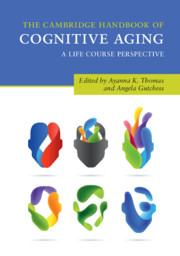Book contents
- The Cambridge Handbook of Cognitive Aging
- The Cambridge Handbook of Cognitive Aging
- Copyright page
- Contents
- Figures
- Tables
- Contributors
- Introduction
- Part I Models of Cognitive Aging
- Part II Mechanisms of Cognitive Aging
- Part III Aging in a Socioemotional Context
- Part IV Cognitive, Social, and Biological Factors across the Lifespan
- Part V Later Life and Interventions
- 32 Cerebrovascular Disease, Aging, and Depression: Clinical Features, Pathophysiology, and Treatment
- 33 The Role of Nutrition in Cognitive Decline
- 34 The Role of Sleep in Cognitive Aging
- 35 The Relationship between Accelerometer-Derived Metrics of Physical Activity and Cognition among Older Adults
- 36 Far Transfer and Cognitive Training: Examination of Two Hypotheses on Mechanisms
- 37 Maximizing the Impact of Cognitive Engagement Interventions for Older Adults
- 38 Mobility and Cognitive Decline in Older Adults with Cognitive Impairment
- 39 Current and Emerging Technologies for Supporting Successful Aging
- Part V Summary: Later Life and Interventions
- Index
- Plate Section (PDF Only)
- References
36 - Far Transfer and Cognitive Training: Examination of Two Hypotheses on Mechanisms
from Part V - Later Life and Interventions
Published online by Cambridge University Press: 28 May 2020
- The Cambridge Handbook of Cognitive Aging
- The Cambridge Handbook of Cognitive Aging
- Copyright page
- Contents
- Figures
- Tables
- Contributors
- Introduction
- Part I Models of Cognitive Aging
- Part II Mechanisms of Cognitive Aging
- Part III Aging in a Socioemotional Context
- Part IV Cognitive, Social, and Biological Factors across the Lifespan
- Part V Later Life and Interventions
- 32 Cerebrovascular Disease, Aging, and Depression: Clinical Features, Pathophysiology, and Treatment
- 33 The Role of Nutrition in Cognitive Decline
- 34 The Role of Sleep in Cognitive Aging
- 35 The Relationship between Accelerometer-Derived Metrics of Physical Activity and Cognition among Older Adults
- 36 Far Transfer and Cognitive Training: Examination of Two Hypotheses on Mechanisms
- 37 Maximizing the Impact of Cognitive Engagement Interventions for Older Adults
- 38 Mobility and Cognitive Decline in Older Adults with Cognitive Impairment
- 39 Current and Emerging Technologies for Supporting Successful Aging
- Part V Summary: Later Life and Interventions
- Index
- Plate Section (PDF Only)
- References
Summary
Even healthy older people undergo some cognitive decline with real-world consequences, although the neural plasticity persisting in older brains indicates substrates for interventions. Yet there is no consensus on cognitive interventions. The literature on cognitive training is equivocal regarding the factors important in far transfer of training to untrained abilities. That there have been few hypotheses on mechanisms underlying far transfer of training is an obstacle to the design of cognitive interventions. We evaluate two hypotheses: (1) updating and (2) distraction suppression. (1) The updating hypothesis argues that updating and monitoring of working memory representations is an important mechanism of far transfer of training. Two meta-analyses of n-back training tasks found small, but significant, effect sizes in favor of transfer to fluid intelligence (Gf) in young and older people. However, direct tests of the updating hypothesis supported only narrow transfer effects. (2) The distraction suppression hypothesis argues that suppression of irrelevant events has a central role in cognitive processing. Perceptual discrimination training improved distraction suppression, enhanced neural activity associated with task-relevant targets, suppressed neural activity associated with task-irrelevant distractions, improved brain-stem evoked potential firing patterns and “speech-in-noise” perception, transferred to working memory, and reduced risk of dementia in a large-scale study. The evidence supports the conclusion that the strongest far transfer of cognitive training would be achieved by combined updating and distraction suppression training. Even small effect sizes of transfer to Gf can be beneficial to older people, consistent with the growing evidence for the role of lifestyle factors, including educational attainment, in risk of Alzheimer’s disease.
Keywords
- Type
- Chapter
- Information
- The Cambridge Handbook of Cognitive AgingA Life Course Perspective, pp. 666 - 684Publisher: Cambridge University PressPrint publication year: 2020

